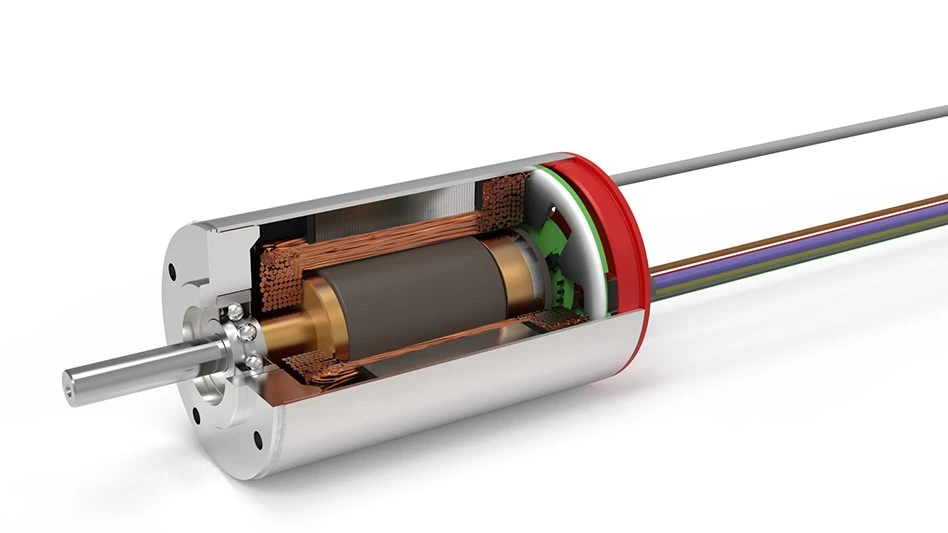
Portescap
A key aspect of brushless DC (BLDC) motor performance is efficiency: the ratio of the mechanical power output achieved from the electrical power input. An efficient motor design minimizes heat generation, not only as this impacts power consumption, but also because it determines a motor’s physical space requirements. A small footprint is key, but inefficient heat management can ultimately limit a motor’s speed and torque generation.
Design considerations that impact motor efficiency include friction losses, resulting from the motor’s bearings, as well as joule losses caused by resistance of the coil. In addition to these factors, iron losses relate to the frequency of the variation of the magnetic flux (the measurement of the magnetic field), as it passes into a material. The faster a motor rotates, the more iron losses that are generated.
How iron losses are caused
To illustrate this phenomenon, if a magnet is dropped through a ferromagnetic tube, the speed of fall is slower than it would be if the tube were made of a non-ferromagnetic material. This is a result of Lenz’s law, which explains that the change of magnetic field induces currents flowing in the opposite direction. In turn, this reduces the speed of the magnet.
This same phenomenon applies to the magnets on the rotor of a BLDC motor. Iron losses are generated by eddy currents and the effect of hysteresis. Eddy currents are explained by Faraday’s Law, which says that when a magnetic field is applied to a conducting material, a current is generated through it. Each type of material has specific electrical resistivity, the higher the resistivity, the greater the losses.
In a BLDC motor, the extent of eddy losses depends on its design and materials. The frequency and intensity of the magnetic field reversal has a substantial impact, as does the speed of the motor. The thickness of the material in the motor’s core also plays an important role. An effective way of reducing the impact of the material’s thickness is by laminating the core material with thin sheets. This creates a smaller path for the current to travel through, splitting it into several small currents, minimizing the impacts of resistance.
In addition to eddy currents, the other primary cause of iron losses is hysteresis. This means that when the magnetic flux is reversed into a ferromagnetic material, the magnetizing and demagnetizing effect creates an energy loss. These losses depend primarily on the magnetic induction in the circuit, as well as the frequency of flux variation, meaning that its key to select the right motor core material for the desired speed.
BLDC design considerations
Taking losses into account is vital because of the limitations they place on a motor’s power output. Failure to do so would cause excessive heating that would damage or ultimately burn out the motor. It’s also crucial to select the right motor for the working point, considering the required speed and torque of operation. Joule losses are mainly generated when creating torque, while iron losses are usually generated at high speed, so when the maximum continuous speed increases, the maximum continuous torque decreases, and vice versa.
The number of poles must also be considered as part of the motor’s design. Adding poles increases torque, but will also increase iron losses, as a result of the higher frequency of magnetic flux variation. This reduces the maximum continuous speed, meaning that when comparing motors running at constant speeds, a four-pole motor loses torque capabilities more quickly than a two-pole equivalent.
Selecting a motor manufacturer
As a result of a motor’s thermal limitations, it’s essential to consider the impact of losses. Minimizing iron losses is crucial to efficiency, especially for high, continuous speed operations, and they must be balanced in an optimized ratio with joule losses.
Each application has its own specific requirements, so it’s crucial that the selected motor engineering team understands the impact of the different types of losses. In addition to designing motors with high performance and efficiency, Portescap’s engineers work across a variety of applications to design motors that achieve the required working point, with a compact and reliable package.
Latest from Today's Medical Developments
- IMTS 2026 runs Sept. 14-19 at McCormick Place in Chicago, Illinois
- Master Bond’s MasterSil 800Med
- ZEISS celebrates 100 years of advancing innovation in the US
- Teleflex sells acute care and urology businesses for $2.03 billion
- HANNOVER MESSE: Where research and manufacturing meet
- What’s next for the design and manufacturing industry in 2026?
- Arcline to sell Medical Manufacturing Technologies to Perimeter Solutions
- Decline in German machine tool orders bottoming out





